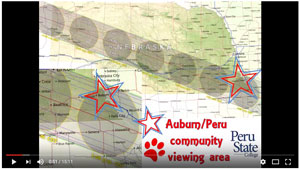FOR IMMEDIATE RELEASE
11:30 a.m., August 15, 2017
Jason R. Hogue, Director of Communications, Peru State College, jhogue@peru.edu, 402-872-2429
Peru, Nebraska- Hannah Van Gundy, a graduate student at Peru State, has created an informational
video about the upcoming eclipse in southeast Nebraska. The video focuses on the
eclipse's effects in Auburn and can be found at www.peru.edu/eclipse.
NASA (National Aeronautics and Space Administration) predicted that on August 21 a
solar eclipse will be visible in a long band from Oregon to South Carolina. A solar
eclipse occurs when the moon orbits directly between the sun and the earth, overshadowing
an area on the earth from sunlight.
While solar eclipses happen every few years, it is rarer for an eclipse to happen
in the same location, creating a rare and unique opportunity for the people living
in the narrow band of the total eclipse that runs through southeast Nebraska and northwest
Missouri.
Van Gundy’s video begins, “The areas and towns within close proximity to Auburn should
encounter almost exactly the same sight. As you can see here, the dark shaded path
is the path of totality.”

Screenshot of Van Gundy's YouTube Video showing the path of totality through Auburn,
Peru and surrounding communities. Original graphic courtesy of NASA.
Creating the Video
Jason Hogue, director of Marketing and Communication at Peru State, writes, “Part
of the College’s proposed engagement in southeast Nebraska schools was to provide
educational resources related to the eclipse. Dr. Darolyn Seay and Hanna Van Gundy
have done incredible work to connect this national, celestial event to our communities.”
Dr. Darolyn Seay, assistant professor of education, writes, “The eclipse video project
was not only a way for Hannah to demonstrate graduate level work implementing technology,
but also gave the College an incredible opportunity to take a once in a lifetime event
and create an engaging video making the connection between our campus, future educators,
and community members from surrounding areas.”
Van Gundy said, “My main focus was to zone in on southeast Nebraska to show people
what they could expect to see here and when it would take place in our area.”
“Another focus was to create a project that was suitable for all ages, so that it
could be shared with local area teachers, college students, and many other community
members.”
Eclipse Vision Safety
Van Gundy’s video continues, “The number one most important thing when it comes to
viewing the eclipse is the safety of your eyes. You never want to look at the sun
without appropriate protection (except during totality).”
“However there are many ways to safely view an eclipse of the sun including certified
eclipse glasses – not sunglasses. They must be eclipse glasses. Another way would
be to make a type of filtering device, indirectly viewing where you project an image
of the sun on a screen.”
Hogue continues, “The College was also able to provide Solar Viewers through Thousand
Oaks Optical to many of the schools and their students in ESU 4. These glasses are
on the list trusted and approved by NASA and the America Astronomical Society.”
Dr. Darren Wright, optometrist at Lifetime Vision, in an interview with Van Gundy
said, “As you probably know, looking at the sun is bad for your eyes.”
Wright explains, “Solar retinopathy is when the retina is damaged by looking at the
sun. The lens in your eye will focus the sun’s rays just like a magnifying glass.”
“If you ever burned anything by focusing the sun’s rays with a magnifying glass, you
can imagine what would happen to your retina!”
Wright continues in the video, “The only time it is going to be safe to look at the
eclipse is if you are in the path of totality, during totality, when none of the bright
edges around the moon are showing the sun.”
“In Auburn, Nebraska, that is going to be for about two minutes. It is the only time
to look at the sun safely. If you see any of the bright sun starting to come back
out, you have to put your solar shades back on.”
Wright concludes, “The solar shades need to be approved solar shades. We worry about
people just having old sun glasses or the disposable glasses they got from being dilated
during an eye exam. Those are not going to be protective. They have to be specifically
for looking at the sun during the eclipse.”
Hogue adds, “More information about viewing safety and a link to the American Astronomical
Society’s list of ‘Reputable Vendors of Solar Filters and Viewers’ can also be found
at www.peru.edu/eclipse.”
More Information about the Video and the Eclipse
Van Gundy’s video goes on to explain the celestial mechanics of the eclipse and other
interesting factors of the upcoming event. The video is fifteen minutes and could
well prepare children and adults for the eclipse.
Seay said, “Hannah did a fantastic job developing this project. She collaborated not
only with me and Dr. Wright, but she also asked for feedback from area teachers and
community members.”
Van Gundy writes, “When given the opportunity, by Dr. Seay, to create a project about
the total solar eclipse, I was eager to get started. Although challenging at times,
I was motivated to construct an informative video about this celestial phenomena that
will happen right here in my community.”
“It was also a great opportunity to collaborate with other community members and bring
something beneficial to the area.”
Van Gundy is seeking her Masters of Education with an emphasis in Curriculum and Instruction.
She is a resident of Auburn.
###
